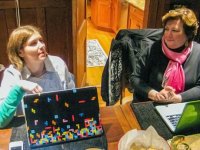Supporting Practice With Emerging Technologies
As we incorporate new technologies in the classroom, we must keep the learning relevant and meaningful. Here are some considerations and resources to help you choose.
Though often considered a supplement to classroom instruction, emerging technologies can and should complement teaching by enhancing differentiation and engagement. However, technologies -- be they hardware or software -- should be a means to an educational end; it is important that the technologies' allure does not obfuscate educational goals to keep learning relevant and meaningful. In their report, The Digital Imperative, Terri Duggan Schwartzbeck and Mary Ann Wolf contended that, "[s]imply slapping a netbook on top of a textbook . . . will not necessarily lead to significant outcomes" (2012, p.8). In other words, the focus should not be on the technologies per se, but rather on how and when the technologies are used.
The How and When of Technology Use
Many emerging technologies are especially helpful in allowing teachers and students to generate, share, and save academic work. Programs such as the Google Suite for Education, Edmodo, and Showbie may have different features, but they offer communication and collaboration affordances that not only support a paperless classroom, but also empower students to be responsible and independent learners. One New Jersey high school teacher explained to me that he asks students to access Showbie and IXL in class so that the assigned sites become integrated into their routine; otherwise, students may view the required sites as supplemental. This highlights the importance of a classroom culture that honors and reinforces student-driven learning, something that is underscored in Mr. Pronovost's classroom when students used specific software to work independently while also meeting face-to-face with the teacher to review core concepts in small groups.
Other programs like Khan Academy that are notorious for their role in teaching students new material (vis-à-vis a flipped learning approach) can be used to support remediation. One New York City high school teacher I spoke with explained that she has used Khan Academy to help reinforce what students have already learned; she noted that students can work at their own pace and revisit the videos at their discretion. When absent students return, she has used Khan Academy videos to help them catch up in class.
Additionally, online sites such as Vocabulary.com provide opportunities to gamify (and modify) traditional vocabulary approaches in and out of school. The site features an adaptive vocabulary game that teachers can integrate into their own classrooms and students can use at home to develop vocabulary skills at their own pace.
With current and emerging technologies, educators need the freedom to select and mix-and-match digital tools to meet student needs and instructional goals. A critical evaluation of a particular device, site, or program will help educators discern how and when to integrate the technology.
Additional Resources for Teachers
Professional organizations, such as the National Council of Teachers of English, the International Literacy Association, the National Council of Teachers of Mathematics, the National Science Teachers Association, and the National Council for the Social Studies, offer a variety of resources to foster the current and future development of educational practice. For instance, the National Council of Teachers of English website includes links to the Read, Write, Think site, which hosts a multitude of lesson plans, online student interactives, and professional development tools. The Literacy in Learning Exchange also provides tools for supporting cross-disciplinary teaching teams.
Similarly, the Literacy Research Association offers links to sites such as the Digital Texts & Tools Online Repository, an open educational resource that is a "living document" featuring lessons, syllabi, tutorials, and blogs for pre-K through university educators. There are cascading opportunities, as many of the embedded links lead to other educators' websites, which, in turn, offer ideas and resources for teaching and learning.
Issues of Access
When we address the use of technologies -- and especially emerging technologies -- there are issues of access that must be acknowledged. These include:
- Potentially prohibitive costs
- Fast and reliable internet access in and out of school
- Availability of compatible devices and platforms
- Options for languages other than English
- Various opportunities for involving and informing parents
Many teachers sense access discrepancies and are careful about how they incorporate technologies. They thoughtfully consider alternatives, such as:
- Scheduling in-class use of technologies
- Offering students time in the computer lab or library
- Being sensitive about how they approach the bring-your-own-device (BYOD) trend so as not to exclude or embarrass students
- Having a contingency plan
The hard reality, at least right now, is that many schools have unreliable hardware and inconsistent internet access. As a result, many teachers need to suddenly change their lessons to include solely non-digital and/or offline activities.
As with many pedagogical challenges, these can be countered with creativity, sensitivity, and resourcefulness. Educators can look to online and offline supports to complement practice and use emerging technologies in meaningful ways.
In the comments below, please share your thoughts and experiences about how you use or plan to use emerging technologies to support your practice.
